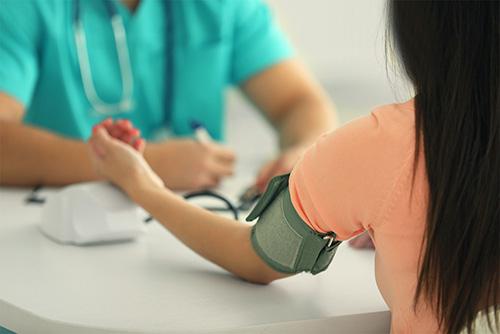
We all know that our blood pressure is checked when we see a medical provider, but most people don’t truly understand what that number represents or why it is important.
What is blood pressure?
Each time your heart beats, it pumps blood through blood vessels called arteries to get the blood throughout your body. This blood provides the oxygen and energy your body needs to function. As the blood is moving through the arteries, it pushes against the sides of those blood vessels. Blood pressure is the force of the blood against the blood vessel walls.
Blood pressure consists of two numbers: systolic and diastolic.
- Systolic blood pressure is the 1st number. This is a measurement of the highest pressure in your arteries when your heart contracts (beats) and forces blood out to the rest of your body.
- Diastolic blood pressure is the 2nd number. This is a measurement of the lowest pressure in your arteries when your heart relaxes between beats.
How is blood pressure measured?
The BP cuff inflates and applies pressure to briefly cut off the blood flow in your arm. When the cuff deflates and the pressure is released, blood starts flowing again. A stethoscope is used to hear when the flow restarts, and that is a measurement of the systolic BP. As the cuff continues to deflate, the beats heard through the stethoscope become quieter and quieter until there is no sound. That is the number that indicates the pressure in your blood vessels when the heart is relaxed (diastolic BP).
What is a normal blood pressure?
Normal BP is less than 120 mmHg for systolic BP and less than 80 mmHg for diastolic BP.
What are the symptoms of high blood pressure?
Usually, there are no symptoms! That’s why hypertension (which is the medical term for high blood pressure) is sometimes called the “silent killer.” Measuring your blood pressure is the only way to know whether you have high blood pressure.
What happens if your blood pressure is too high?
High blood pressure raises your risk for heart attacks, heart failure, strokes, kidney disease, and eye disease. Studies show that when you lower your BP, you lower your risk of heart attack by 20-25% and your risk of stroke by 35-40%.
What kind of lifestyle changes can I make to lower my blood pressure?
Eat a healthy diet and limit your salt intake. Don’t smoke. Get at least 30 minutes of exercise that gets your heart rate up, at least 5 days a week. Manage your stress levels. Keep a healthy weight.
If you have questions or are concerned about your blood pressure, don’t hesitate to contact the Quincy Student Health and Wellness Center at (509) 787-8943!
